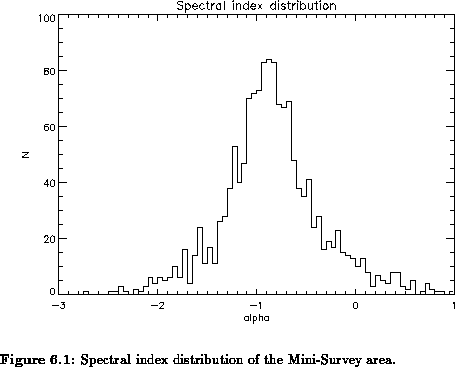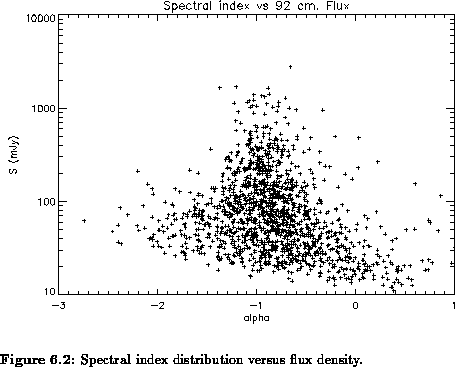A very important aspect of the WENSS survey is comparison of radio sources at different frequencies. Spectral information is essential for finding specific radio sources like distant radio galaxies, millisecond pulsars, gravitational lenses and GPS sources (GHz peakers). It is the first tool we want to use for selecting these sources, because it is a simple technique. With only two frequency points one can make a good guess of the slope of the spectrum.
One of the first things we have done is to compare WENSS data taken at 92 cm
and 49 cm. One has to be careful when sources at different frequencies are
compared, because the observations are done at different resolutions.
This means that it is possible a source is unresolved at 92 cm (54 arcsec
resolution) but resolved at 49 cm (29 arcsec resolution). Features of the
source at 92 cm can be smeared out while they show structure at 49 cm. This
will give a wrong estimate of the spectral index, although we don't think
this will be a big effect. The difference in resolution is not dramatic and
sources that are resolved at 49 cm will only be slightly resolved, since
most radio sources have an angular size of . Sources that
are smaller
won't give big errors because they will be unresolved at both wavelengths and
very big radio sources (bigger than
) will not be taken into account in
our first research projects.

Figure 6.1 shows the histogram of the spectral index distribution of the
Mini-Survey area, with data taken at 92 and 49 cm. The criterium for
detecting the sources at both frequencies was finding a source within 30
arcsec.
Multiple component sources were added to get the total integrated flux.
The source lists are complete downto the level. This means a
flux cutoff of about 25 mJy at 92 cm and 18-20 mJy at 49 cm.

Figure 6.2 again shows the spectral index distribution, but now versus the flux density at 92 cm. Wieringa (1991) reports marginally significant differences of the spectral index distributions between different fields at different locations. In the near future a comparison will be made between the Mini-Survey area and other regions. At this moment no differences have been found. A larger area of sky is needed to make such statistical claims.